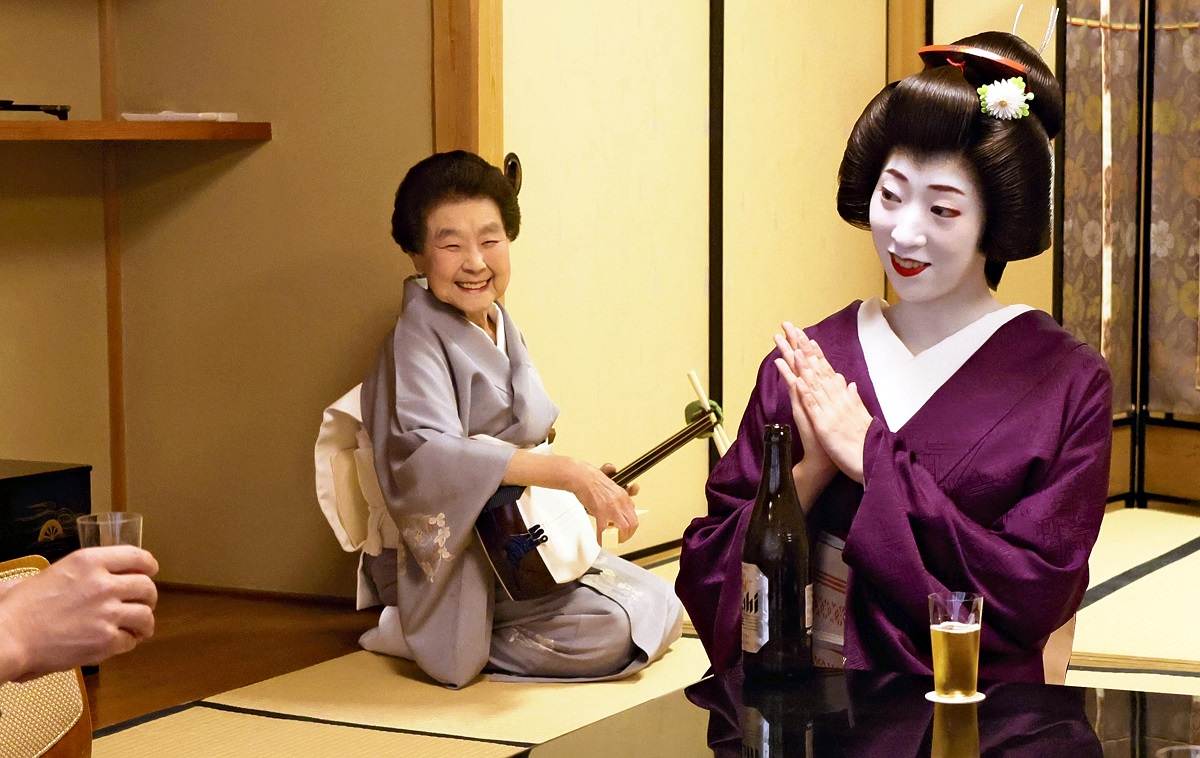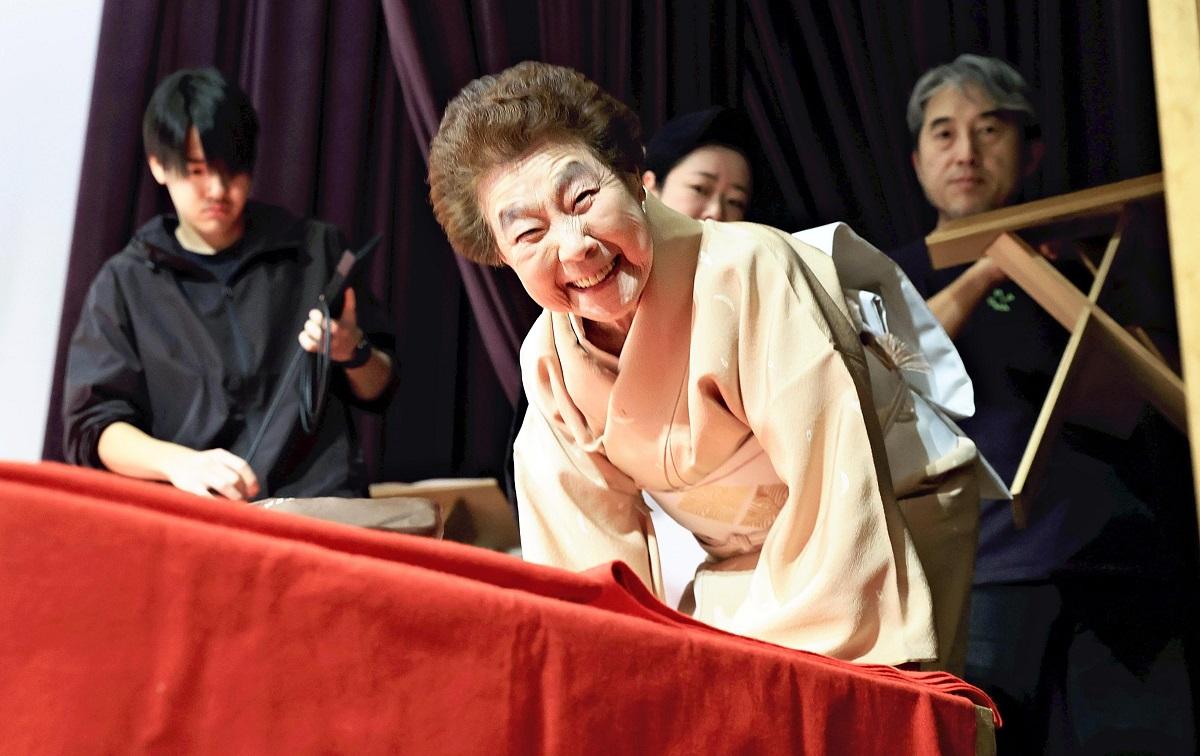Kyoto Geiko Quarters / Appeal to International Audiences a Requirement of New Era Geiko District

Tae, right, and Taeno are seen at the entrance of the Koma-ya geiko house in Higashiyama Ward, Kyoto, on Dec. 13.
By Asako Kisui / Yomiuri Shimbun Senior Writer
11:00 JST, January 13, 2024
This is the third and final installment in a series that follows two women in Miyagawacho, one of the five “kagai” geiko quarters in Kyoto — a 91-year-old veteran and a 26-year-old who became a geiko a year ago.
***
With the dissipation of the COVID-19 pandemic, sightseeing spots in Kyoto such as Kiyomizu Temple and Nishiki market are once again crowded with foreign tourists.
In 2023, a travel agency that specializes in inbound tourism repeatedly requested the dispatch of geiko entertainers from the Koma-ya teahouse and okiya live-in establishment in the Miyagawacho district of the city.
Catering to foreign tourists allows Taeno, 26, to show off her skills. The young geiko attended university and studied in Britain and China before entering her current profession, taking a less-traveled path than most of her peers who complete their maiko training while in their teens, before becoming a geiko. Taeno entertains wealthy guests from the United States and other countries at upscale ryotei Japanese restaurants three or four times each week.
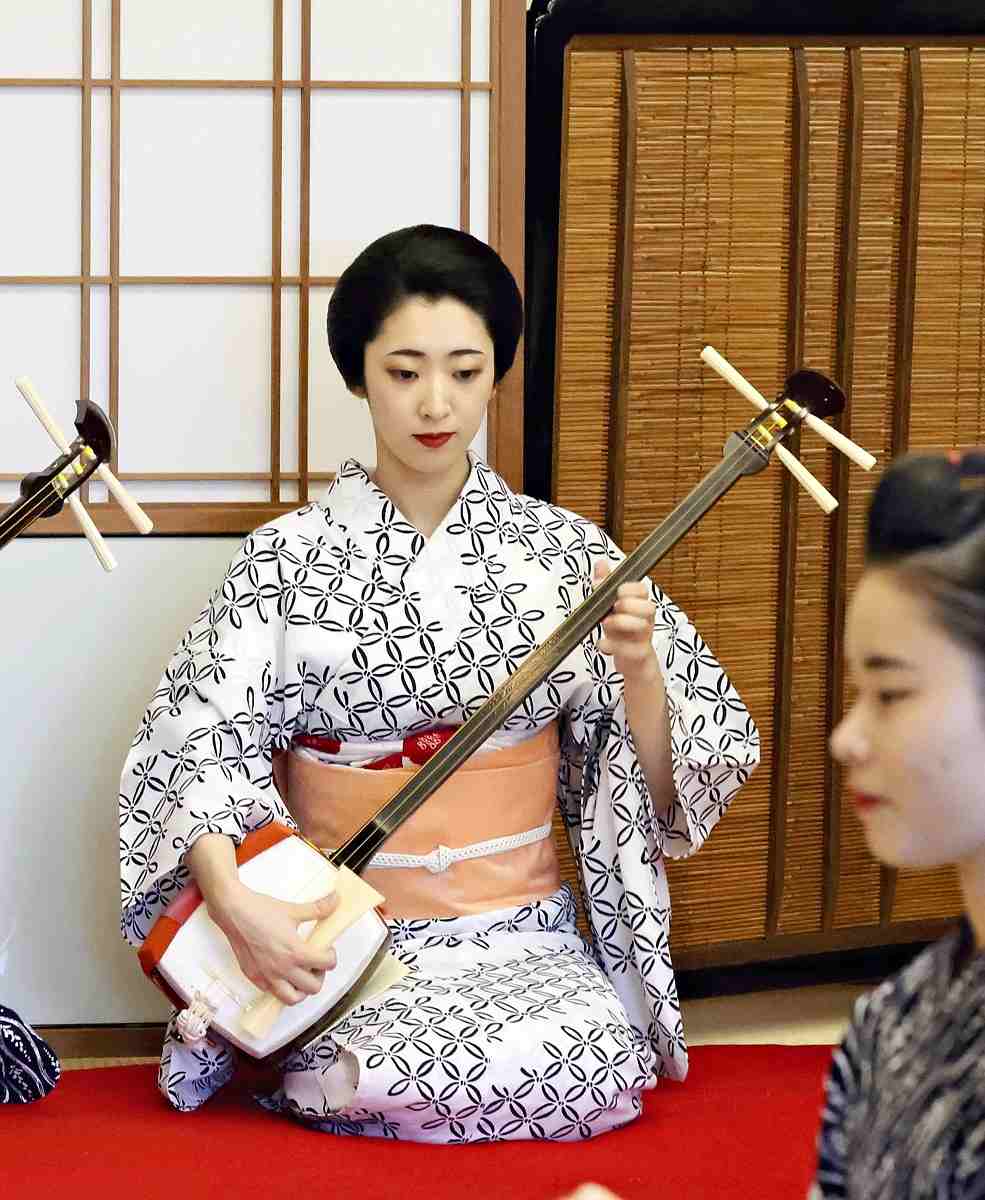
Taeno plays the shamisen during a recital of nagauta music performances by maiko and geiko in Kyoto in September.
Japanese companies often call upon the services of teahouses when entertaining foreign clients. Kozo Azuma, 56, the president of an Osaka-based company that produces and sells electrical machinery parts, booked Taeno’s services when entertaining a client from China.
“She [Taeno] had a lively conversation with the client using some Chinese words, which helped break the ice among us,” Azuma said. “My client was very happy about that.”
Taeno always teaches foreign guests the word “okini,” a Kyoto-dialect term meaning “thank you.” She explains the meaning to guests in English or Chinese so they can use the word with a smile. Taeno said that explaining “okini” helps her guests become familiar with a word that has its roots in the lives of the Kyoto people.
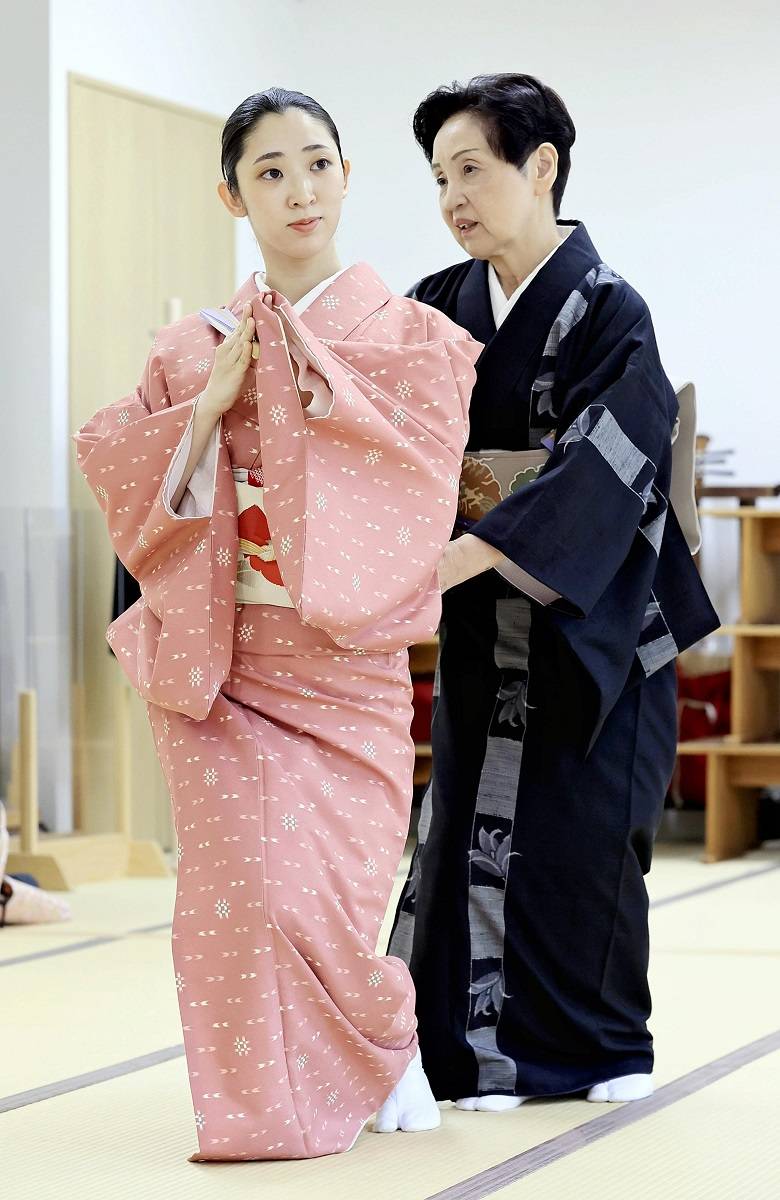
Taeno, left, receives a lesson on traditional Japanese dance by an instructor in Kyoto in December.
Since becoming a geiko in November 2022, Taeno has made a debut as a dancer, a shamisen player and a player of kiyomoto, a type of Joruri narrative recitation.
“[When performing for the first time] I was always so nervous that my heart was pounding, but I was able to pull through thanks to my big sister,” Taeno said, touching upon her relationship with Tae, a 91-year-old geiko with whom Taeno has made a pledge of sisterhood. Taeno vows to further improve her skills.
New theater
Miyagawacho is about to enter a new era. A kaburenjo theater, a home venue for performances by the quarter’s geiko, will be renewed by 2025 when the Osaka-Kansai Expo will be held. The new facility will be developed together with a yet-to-be-built luxury hotel run by a Singapore-based company adjacent to the theater, recreating the large roof of the former theater to pass on the tradition.
Taeno is looking forward to dancing to Tae’s shamisen-playing at the new theater. “I’ll do my utmost to catch up with my ‘big sister,’” she said.
Tae, meanwhile, expressed her determination to continue within the geiko profession, saying, “I want to be a geiko as long as I’m healthy, because that’s just the way I live.”
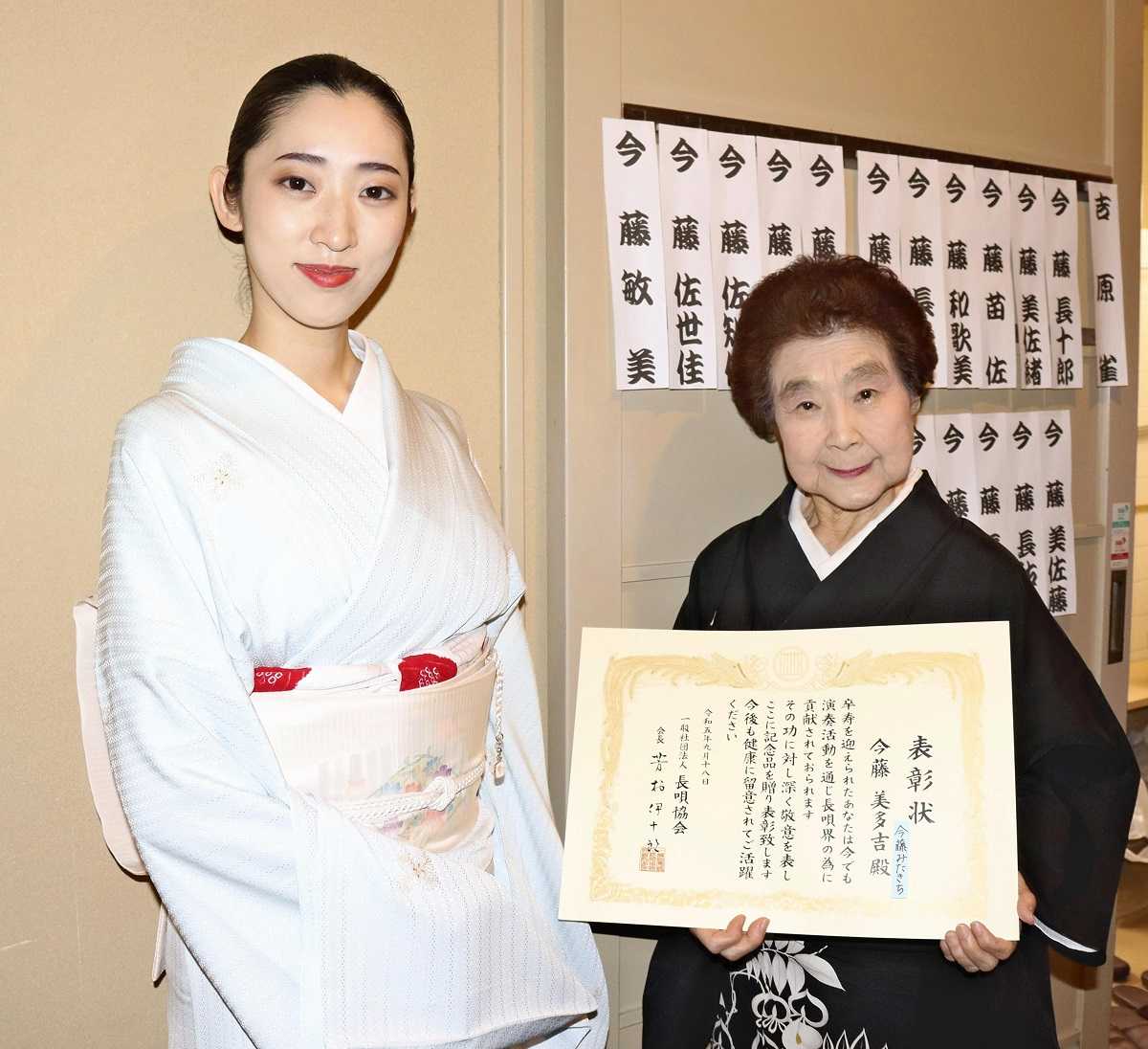
Tae, right, receives a certificate for a nagauta music performance, accompanied by Taeno, in Osaka in September.
Related Articles
Popular Articles
Popular articles in the past 24 hours
-

Bank of Japan Considered U.S. Tariffs, Coming Shunto Wage Hike Ta...
-

Japan's 1st Domestically Manufactured EV Police Motorcycle Unveil...
-

Kumamoto: Trams to Continue Accepting IC Cards after Strong Oppos...
-

Yen Weakens against Peers after BOJ Raises Interest Rates
-

Colorful New Year Lucky Charm Production Reaches Peak in Shizuoka...
-

Coffee Omakase Is Japan's Love Letter to Caffeine
-

Earthquake with Focus Directly Under Tokyo Could Cause ¥83 Tril. ...
-

Man Found Dead near Trapped Bear in Miyagi Pref.; Victim May Have...
Popular articles in the past week
-

Tsukiji Market Urges Tourists to Avoid Visiting in Year-End
-

Israeli Tourists Refused Accommodation at Hotel in Japan’s Nagano...
-

China to Impose Sanctions on Shigeru Iwasaki, Former Head of Japa...
-

Japan to Support Central Asian Logistics Route That Bypasses Russ...
-

U.S. Senate Resolution Backs Japan, Condemns China's Pressure
-

Speed Skater Yukino Yoshida Clinches Ticket to Milan
-

Kenta Maeda Joins Rakuten Eagles; Returns from American MLB to Ja...
-

Sharp Decline in Number of Chinese Tourists But Overall Number of...
Popular articles in the past month
-

Keidanren Chairman Yoshinobu Tsutsui Visits Kashiwazaki-Kariwa Nu...
-

Imports of Rare Earths from China Facing Delays, May Be Caused by...
-

Japan Exports Rise in October as Slump in U.S. Sales Eases
-

University of Tokyo Professor Discusses Japanese Economic Securit...
-

Japan Pulls out of Vietnam Nuclear Project, Complicating Hanoi's ...
-

Govt Aims to Expand NISA Program Lineup, Abolish Age Restriction
-

Blanket Eel Trade Restrictions Rejected
-

Key Japan Labor Group to Seek Pay Scale Hike
"Society" POPULAR ARTICLE
-

M4.9 Earthquake Hits Tokyo, Neighboring Prefectures
-

M7.5 Earthquake Hits Northern Japan; Tsunami Waves Observed in Hokkaido, Aomori and Iwate Prefectures
-

Tsukiji Market Urges Tourists to Avoid Visiting in Year-End
-

Israeli Tourists Refused Accommodation at Hotel in Japan’s Nagano Pref., Prompting Protest by Israeli Embassy and Probe by Prefecture
-

M5.7 Earthquake Hits Japan’s Kumamoto Pref., Measuring Upper 5 Intensity, No Tsunami Expected
JN ACCESS RANKING
-

Keidanren Chairman Yoshinobu Tsutsui Visits Kashiwazaki-Kariwa Nuclear Power Plant; Inspects New Emergency Safety System
-

Imports of Rare Earths from China Facing Delays, May Be Caused by Deterioration of Japan-China Relations
-

University of Tokyo Professor Discusses Japanese Economic Security in Interview Ahead of Forum
-

Japan Pulls out of Vietnam Nuclear Project, Complicating Hanoi’s Power Plans
-

Govt Aims to Expand NISA Program Lineup, Abolish Age Restriction
